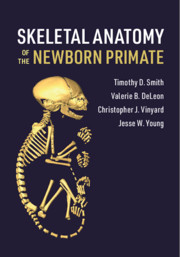Crossref Citations
This Book has been
cited by the following publications. This list is generated based on data provided by Crossref.
Paddock, Kelsey
Zeigler, Larissa
Harvey, Brianna
Prufrock, Kristen A.
Liptak, Jordan M.
Ficorilli, Courtney M.
Hogg, Russell T.
Bonar, Christopher J.
Evans, Sian
Williams, Lawrence
Vinyard, Christopher J.
DeLeon, Valerie B.
and
Smith, Timothy D.
2020.
Comparative dental anatomy in newborn primates: Cusp mineralization.
The Anatomical Record,
Vol. 303,
Issue. 9,
p.
2415.
Mano, Nanami
Wood, Brody
Oladipupo, Lanre
Reynolds, Rebecca
Taylor, Jane
Durham, Emily
Cray, James J.
Vinyard, Christopher
DeLeon, Valerie B.
and
Smith, Timothy D.
2021.
The chondrocranial key: Fetal and perinatal morphogenesis of the sphenoid bone in primates.
Vertebrate Zoology,
Vol. 71,
Issue. ,
p.
535.
Smith, Timothy D.
Ufelle, Alexander C.
Cray, James J.
Rehorek, Susan B.
and
DeLeon, Valerie B.
2021.
Inward collapse of the nasal cavity: Perinatal consolidation of the midface and cranial base in primates.
The Anatomical Record,
Vol. 304,
Issue. 5,
p.
939.
Smith, Timothy D.
Corbin, Hayley M.
King, Scot E. E.
Bhatnagar, Kunwar P.
and
DeLeon, Valerie B.
2021.
A comparison of diceCT and histology for determination of nasal epithelial type.
PeerJ,
Vol. 9,
Issue. ,
p.
e12261.
Smith, Timothy D.
Craven, Brent A.
Engel, Serena M.
Van Valkenburgh, Blaire
and
DeLeon, Valerie B.
2021.
“Mucosal maps” of the canine nasal cavity: Micro‐computed tomography and histology.
The Anatomical Record,
Vol. 304,
Issue. 1,
p.
127.
Laitman, Jeffrey T.
and
Albertine, Kurt H.
2021.
A human's best friend comes to The Anatomical Record: A special issue explores the world of the dog.
The Anatomical Record,
Vol. 304,
Issue. 1,
p.
7.
Bolon, Brad
and
Everitt, Jeffrey I.
2022.
Selected Resources for Pathology Evaluation of Nonhuman Primates in Nonclinical Safety Assessment.
Toxicologic Pathology,
Vol. 50,
Issue. 5,
p.
725.
Leyendecker, Gerhard
Wildt, Ludwig
Laschke, Matthias W.
and
Mall, Gerhard
2022.
Archimetrosis: the evolution of a disease and its extant presentation.
Archives of Gynecology and Obstetrics,
Vol. 307,
Issue. 1,
p.
93.
Esteve-Altava, Borja
2022.
Cranial Anatomical Integration and Disparity Among Bones Discriminate Between Primates and Non-primate Mammals.
Evolutionary Biology,
Vol. 49,
Issue. 1,
p.
37.
Saers, Jaap P. P.
Gordon, Adam D.
Ryan, Timothy M.
and
Stock, Jay T.
2022.
Trabecular bone ontogeny tracks neural development and life history among humans and non-human primates.
Proceedings of the National Academy of Sciences,
Vol. 119,
Issue. 49,
Smith, Timothy D.
Ruf, Irina
and
DeLeon, Valerie B.
2023.
Ontogenetic transformation of the cartilaginous nasal capsule in mammals, a review with new observations on bats.
The Anatomical Record,
Maier, Wolfgang
Lächele, Ulla
and
Ruf, Irina
2023.
Craniogenetic studies in Sus scrofa: With emphasis on the ‘orbitosphenoid’ problem.
The Anatomical Record,
Smith, Timothy D.
Prufrock, Kristen A.
and
DeLeon, Valerie B.
2023.
How to make a vampire.
The Anatomical Record,
Vol. 306,
Issue. 11,
p.
2872.
Granatosky and, Michael C.
and
Young, Jesse W.
2023.
A Companion to Biological Anthropology.
p.
587.
Smith, Timothy D.
Zinreich, S. James
Márquez, Samuel
King, Scot E. E.
Evans, Sian
and
DeLeon, Valerie B.
2024.
Growth and microanatomy of the paranasal sinuses in two species of New World monkeys.
The Anatomical Record,
Vol. 307,
Issue. 1,
p.
49.





